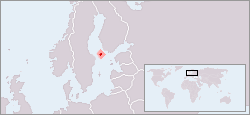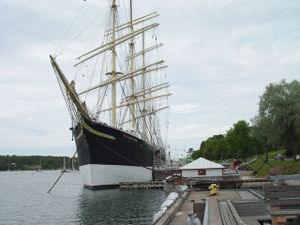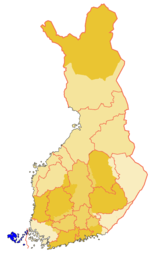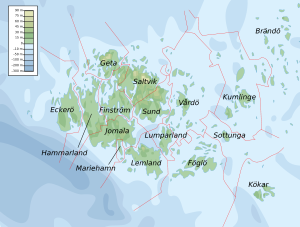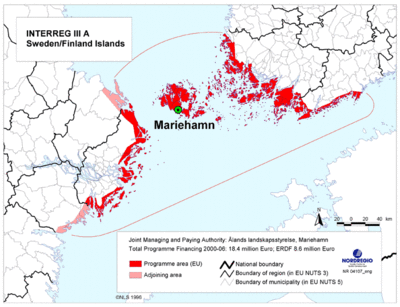Åland Islands
2008/9 Schools Wikipedia Selection. Related subjects: Europe; European Countries
| Landskapet Åland Ahvenanmaan maakunta Åland Islands
|
||||||
|---|---|---|---|---|---|---|
|
||||||
| Motto: "Islands of Peace" | ||||||
| Anthem: Ålänningens sång |
||||||
|
|
||||||
| Capital (and largest city) |
Mariehamn |
|||||
| Official languages | Swedish | |||||
| Government | Autonomous province | |||||
| - | Governor | Peter Lindbäck1 | ||||
| - | Premier | Viveka Eriksson | ||||
| Autonomy | ||||||
| - | Declared | 1920 | ||||
| - | Recognized | 19212 | ||||
| EU accession | January 1, 19953 | |||||
| Area | ||||||
| - | Total | 13,517 km² ( unranked) 5,267 sq mi |
||||
| - | Water (%) | 89 | ||||
| Population | ||||||
| - | 2008 estimate | 27 210 | ||||
| - | Density | 17.6/km² 45.6/sq mi |
||||
| Currency | Euro (€)4 ( EUR) |
|||||
| Time zone | EET ( UTC+2) | |||||
| - | Summer ( DST) | EEST ( UTC+3) | ||||
| Internet TLD | .ax5 | |||||
| Calling code | +358 (area code 18) | |||||
| 1 | The governor is an administrative post appointed by the Government of Finland, and does not have any authority over the autonomous Government of Åland. | |||||
| 2 | Settled by the League of Nations following the Åland crisis. | |||||
| 3 | Åland held a separate referendum and then joined at the same time as the rest of Finland. | |||||
| 4 | Until 1999, the Finnish mark. | |||||
| 5 | Replacing .aland.fi from August 2006.The .eu domain is also used, as it is shared with Finland and the rest of European Union member states. | |||||
The Åland Islands ( Swedish: Åland (pronounced IPA: ['oːland]), Finnish: Ahvenanmaa) form an archipelago in the Baltic Sea. It is situated at the entrance to the Gulf of Bothnia and forms an autonomous, demilitarized, monolingually Swedish-speaking administrative province, region and historical province of Finland. It is the smallest province of Finland, comprising 0.50% of Finland's population and 0.49% of land area.
The islands consist of the main island Fasta Åland (where 90% of the population resides) and an archipelago to the east that consists of over 6,500 skerries and islands. Fasta Åland is separated from the coast of Sweden by forty kilometres (twenty-five miles) of open water to the west. In the east, the Åland archipelago is virtually contiguous with the Finnish Archipelago Sea. Åland's only land border is short and strangely shaped; it is located on the uninhabited island of Märket, which it shares with Sweden. That border was re-negotiated in 1985.
Due to Åland's autonomous status, the powers exercised at the provincial level by representatives of the central state administration in the rest of Finland are largely exercised by the Government of Åland in Åland.
Autonomy of Åland
The autonomous status of the islands was affirmed by a decision made by the League of Nations in 1921 following the Åland crisis. It was reaffirmed within the treaty admitting Finland to the European Union. By law, Åland is politically neutral and entirely demilitarised, and residents are exempt from conscription to the Finnish Defence Forces. The islands were granted extensive autonomy by the Parliament of Finland in the Act on the Autonomy of Åland of 1920, which was last replaced by new legislation by the same name in 1951 and 1991.
In connection with Finland's admission to the European Union, a protocol was signed concerning the Åland Islands that stipulates, among other things, that provisions of the European Community Treaty shall not force a change of the existing restrictions for foreigners (i.e., persons who do not enjoy "home region rights" (hembygdsrätt) in Åland) to acquire and hold real property or to provide certain services, implying a recognition of a separate nationality.
Name
According to one theory, Åland's original name was Germanic *Ahvaland which means "Land of Water". In Swedish, this first developed into Áland and eventually into Åland, literally "river land"—even though rivers are not a prominent feature of Åland's geography. The Finnish name of the island, Ahvenanmaa (" perch land"), is seen to preserve another form of the old name.
Another theory suggests that the Finnish Ahvenanmaa would be the original name of the archipelago, from which the Swedish Åland derives.
History
The Åland Islands were part of the territory ceded to Russia by Sweden under the Treaty of Fredrikshamn in September 1809. As a result, along with all other parts of Finland, they became part of the semi- autonomous Grand Duchy of Finland.
During this process, Sweden was unable to secure a provision that the islands not be fortified. The issue was important not only for Sweden but also for the United Kingdom, which was concerned that a military presence on the islands could threaten Britain's security and commercial interests.
In 1832, Russia started to fortify the islands with the great fortress of Bomarsund. This was captured and destroyed by a combined British and French force of warships and marines in 1854 as part of the campaign in the Baltic during the Crimean War. In the Treaty of Paris (1856), the entire Åland Islands were demilitarized.
During the Finnish Civil War, in 1918, Swedish troops intervened as a peacekeeping force between the Russian troops stationed on the islands and "White" and "Red" Finnish troops that came from Finland over the frozen sea. Historians, however, point out that Sweden may have in reality planned to occupy the islands. Within weeks, the Swedish troops gave way to German troops that occupied Åland by request of the "White" ( conservative) Finnish Senate.
After 1917, the residents of the islands worked towards having the islands ceded to Sweden. A petition for secession from Finland was signed by 96.2% of Åland's native adults (those working or living abroad excluded), although serious questions were later raised regarding this extraordinarily high figure. Swedish nationalist sentiments had grown strong particularly due to the following issues: anti-Swedish tendencies in Finland, Finnish nationalism fuelled by Finland's struggle to retain its autonomy, and the Finnish resistance against Russification. In addition, the conflict between the Swedish-speaking minority and the Finnish-speaking majority (on the mainland), which since the 1840s had been prominent in Finland's political life, contributed to the Åland population's apprehension about its future in Finland.
Finland was, however, not willing to cede the islands and instead offered them an autonomous status. Nevertheless the residents did not approve the offer, and the dispute over the islands was submitted to the League of Nations. The latter decided that Finland should retain sovereignty over the province but that the Åland Islands should be made an autonomous territory. Thus Finland was obliged to ensure the residents of the Åland Islands the right to maintain the Swedish language, as well as their own culture and local traditions. At the same time, an international treaty established the neutral status of Åland, whereby it was prohibited to place military headquarters or forces on the islands.
In the course of the twentieth century, increasing numbers of the islanders have perceived Finnish sovereignty as benevolent and even beneficial. The combination of disappointment about insufficient support from Sweden in the League of Nations, Swedish disrespect for Åland's demilitarised status in the 1930s, and some feelings of a shared destiny with Finland during and after World War II has changed the islanders' perception of Åland's relation to Finland from "a Swedish province in Finnish possession" to "an autonomous part of Finland". The islanders enjoyed safety at sea during WWII as their merchant fleet sailed for both the allied countries and the Germans. Consequently Åland shipping was not generally attacked as each side rarely knew what cargo was being carried for who.
Politics

The Åland Islands are governed according to the Act on the Autonomy of Åland and international treaties. These laws guarantee the islands' autonomy from Finland, which has ultimate sovereignty over them, as well as a demilitarized status. The Government of Åland, or Landskapsregering, answers to the Parliament of Åland, or Lagting, in accordance with the principles of parliamentarism.
Åland has its own national flag, has issued its own postage stamps since 1984, runs its own police force, and is a member of the Nordic Council. Since 2005 the Åland Islands also have had their own national airline, Air Åland. The islands are demilitarised, and the population is exempt from conscription. Although Åland's autonomy preceded the creation of the regions of Finland, the autonomous government of Åland also has responsibility for the functions undertaken by Finland's regional councils. Åland is a member of the Small European Postal Administration Cooperation.
The Åland Islands are guaranteed representation in the Finnish parliament, to which they elect one representative. Åland also has different system of political parties than the mainland (see List of political parties in Finland).
Administration
The State Provincial Office on the Åland Islands has a somewhat different function from the other Provinces of Finland, due to its autonomy. Generally, a State Provincial Office is a joint regional authority of seven different ministries of the Government of Finland. In Åland, the State Provincial Office also represents a set of other authorities of the central government, which in Mainland Finland has separate bureaucracies. On the other hand, duties which in Mainland Finland are handled by the provincial offices are transferred to the autonomous government of Åland.
Åland has its own post office but uses the Finnish five-digit postal code system, in which postal codes beginning with 22XXX are reserved for it. The lowest numbered postal code is for the capital Mariehamn, 22100, and the highest 22950 for Jurmo.
Municipalities
|
|
|
|
|
Geography
The Åland Islands occupy a position of great strategic importance, as they command one of the entrances to the port of Stockholm, as well as the approaches to the Gulf of Bothnia, in addition to being situated near the Gulf of Finland.
The Åland archipelago consists of nearly three hundred habitable islands, of which about eighty are inhabited; the remainder are merely some 6,000 skerries and desolate rocks. The archipelago is connected to Åboland archipelago in the east ( Finnish: Turunmaan saaristo, Swedish: Åbolands skärgård) — the archipelago adjacent to the southwest coast of Finland. Together they form the Archipelago Sea. To West from Åland is Sea of Åland and to North the Botnian Sea.
The surface of the islands is generally rocky, the soil thin, and the climate keen. There are several excellent harbours.
The islands' landmass occupies a total area of 1,512 square kilometres (583 sq. mi). Ninety per cent of the population live on Fasta Åland (the Main Island), also the site of the capital town of Mariehamn. Fasta Åland is the largest island in the archipelago, extending over 1,010 square kilometres, more than 70% of the province's land area, and stretching 50 kilometres (31 mi) from north to south and 45 kilometres (28 mi) from east to west.
During the Åland Crisis, the parties sought support from different maps of the islands. On the Swedish map, the most densely populated main island dominated, and many skerries were left out. On the Finnish map, a lot of smaller islands or skerries were, for technical reasons, given a slightly exaggerated size. The Swedish map made the islands appear to be closer to the mainland of Sweden than to Finland; the Finnish map stressed the continuity of the archipelago between the main island and mainland Finland, while a greater gap appeared between the islands and the archipelago on the Swedish side. Although both Finns and Swedes of course argued for their respective interpretations, in retrospect it is hard to say that one is more correct than the other. One consequence is the oft-repeated number of "over 6,000" skerries that was given authority by the outcome of the arbitration.
Economy
Åland's economy is heavily dominated by shipping, trade and tourism. Shipping represents about 40% of the economy, with several international carriers owned and operated off Åland. Most companies aside from shipping are small, with fewer than ten employees. Farming and fishing are important in combination with the food industry. A few high-profile technology companies contribute to a prosperous economy.
The main ports are Mariehamn (south), Berghamn (west) and Långnäs on the eastern shore of the Main Island.
Mariehamn was the base for the last large oceanic commercial sailing ships in the world. Their final tasks were bringing Australian wheat to Great Britain, on which Aland shipowner Erikson kept going until after WW2, 1947 being his last year. The ships latterly made only one round-trip from South Australia to Britain per year, after each marathon voyage going back to Mariehamn to lay up for a few months. The ship "Pommern", now a museum in Mariehamn, was one of these last vessels.
The abolition of tax-free sales on ferry boats travelling between destinations within the European Union made Finland demand an exception for the Åland Islands on EU's VAT rules. The exception allows for maintained tax-free sales on the ferries between Sweden and Finland (provided they stop at Mariehamn or Långnäs), but has also made Åland a different tax-zone, meaning that tariffs must be levied on goods brought to the islands.
Unemployment is well below that of surrounding regions, 1.8% in 2004.
The Finnish State collects taxes, duties and fees also in Åland. In return, the Finnish Government places a sum of money at the disposal of the Åland Parliament. The sum is 0.45 per cent of total Government income, excluding Government loans. In 2005, the sum was over 225 million USD.
While the official currency is the euro, the Swedish krona also circulates freely in Åland.
Demographics
Most inhabitants have Swedish (the sole official language) as their first language: 91.2% in 2007, and 5.0% speak Finnish. The language of instruction in publicly financed schools is Swedish, but an Ålandic municipality is free to provide teaching of Finnish. (In the rest of Finland, bilingual municipalities provide schooling both in Finnish and in Swedish.) See Åland Swedish for information about the dialect.
Regional citizenship or the right of domicile (kotiseutuoikeus/hembygdsrätt) is a prerequisite for the right to vote or stand as a candidate in elections to the Legislative Assembly, to own and hold real estate in Åland or to exercise without restriction a trade or profession in Åland.
The vast majority of the population, 94.8%, belongs to the Evangelical Lutheran Church.
The issue of the ethnicity of the Ålanders, and the correct linguistic classification of their language, remains somewhat sensitive and controversial. They may be considered either ethnic Swedes or Swedish-speaking Finns, but their language is closer to the adjacent dialects in Sweden, i.e. Uppländska, than to adjacent dialects of Finland Swedish. See Languages of Sweden
- Listen to Ålandish
|
|||||||||||
Sport
- Åland competes in the bi-annual Island Games, which it hosted in 1991 and will host again in 2009.
- IFK Mariehamn is the leading football club. It currently plays in the top level of Finnish football, the Veikkausliiga.
Holidays
| Date | English name | Local name | Remarks |
|---|---|---|---|
| January 1 | New Year's Day | Nyårsdagen | |
| January 6 | Epiphany | Trettondagen | |
| March 30 | Demilitarization Day | Ålands demilitariseringsdag | Peace in 1856 after the Crimean War |
| Moveable Friday | Good Friday | Långfredag | The Friday before Easter Sunday |
| Moveable Sunday | Easter Sunday | Påskdagen | |
| Moveable Monday | Easter Monday | Annandag påsk | The day after Easter Sunday |
| April 30 | Walpurgis Night | Valborgsmässoafton | |
| May 1 | May Day | Första maj | |
| Moveable Thursday | Ascension Day | Kristi himmelsfärdsdag | 39 days after Easter |
| Moveable Sunday | Pentecost | Pingstdagen | 49 days after Easter |
| Moveable Monday | Whitmonday | Annandag Pingst | 50 days after Easter |
| June 9 | Autonomy Day | Självstyrelsedagen | First congregation of the regional government |
| Third Friday of June | Midsummer Eve | Midsommarafton | |
| Third Saturday of June | Midsummer Day | Midsommardagen | |
| First Saturday of November | All Saints Day | Alla helgons dag | |
| December 6 | Independence Day | Självständighetsdagen | Independence of Finland (1917) |
| December 24 | Christmas Eve | Julafton | |
| December 25 | Christmas Day | Juldagen | |
| December 26 | St. Stephen's Day Boxing Day | Annandag jul |
In popular culture
- The Åland Islands are mentioned as the location where the character Hooper Hamilton in H.G. Wells' book The Shape of Things to Come commits suicide.
- In the Bruce Sterling short story, The Littlest Jackal, the Åland Islands feature in an attempted offshore-banking and royalty-lawsuit scam.
- The author Sally Salminen is from the Åland Islands and her novel Katrina takes place there.


